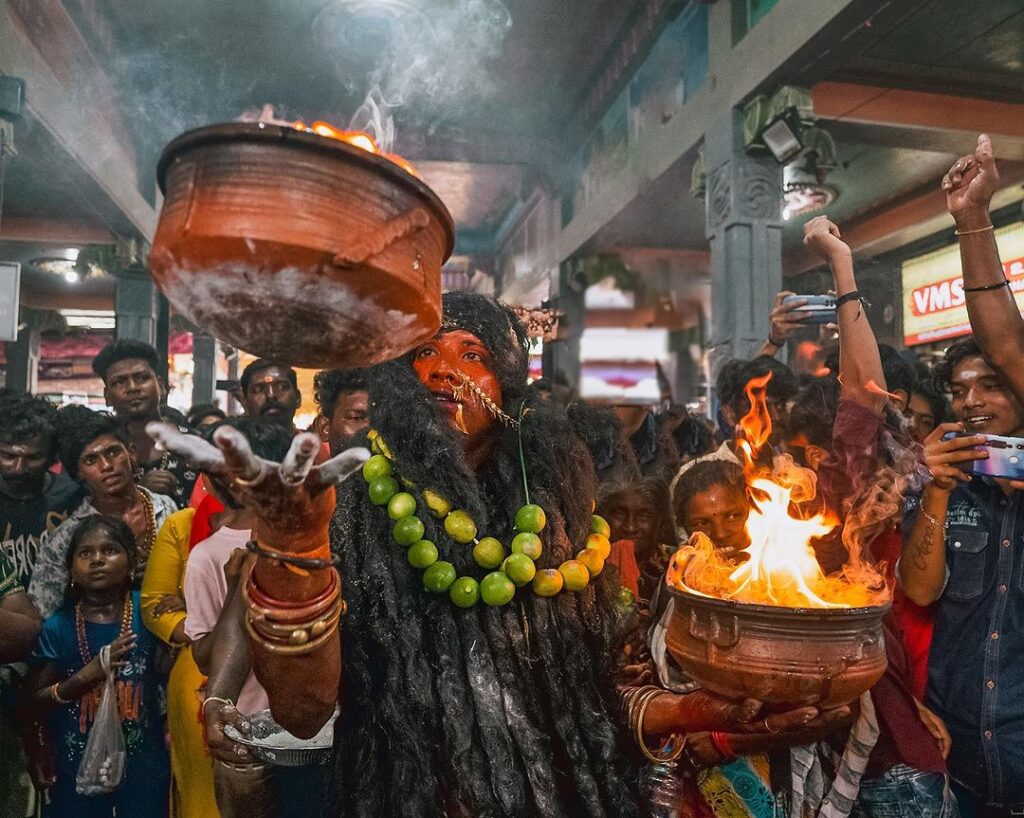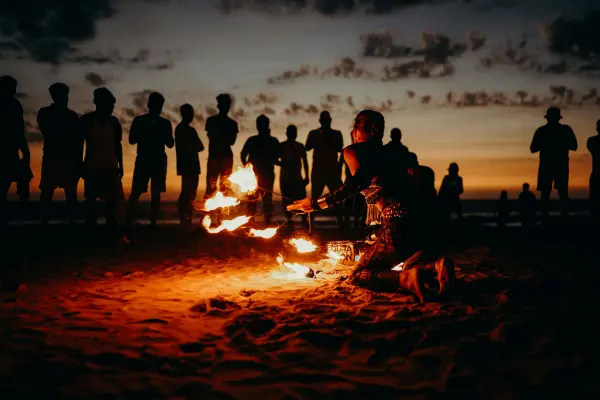Kulasai Dasara, a distinctive and vibrant festival, is celebrated with unparalleled zeal in the coastal town of Kulasekarapattinam in the Thoothukudi district of Tamil Nadu, India. Rooted in centuries of history, this festival is a remarkable fusion of religious fervor, cultural expression, and deep-rooted traditions. Kulasai Dasara is a captivating celebration of good triumphing over evil, and it unfolds in the hallowed precincts of the Sri Mutharamman Temple, a 300-year-old temple that holds immense significance.
Featured Photo Credits – Sumeet Kadakia
The Ultimate Guide to Kulasai Dasara – A Spectacle of Devotion and Tradition
Kulasai: A Place of Legends

Kulasekarapatnam, the location of this grand celebration, is steeped in history. Its name is derived from Pandyan ruler Maravarman Kulasekara Pandyan I and is even mentioned in Marco Polo’s travel diaries dating back to 1250 AD.
The Legend of Mutharamman
At the heart of Kulasai Dasara lies a compelling mythological tale. The festival commemorates the victory of good over the malevolent demon, Magisasuran. Legend has it that the town’s residents, tormented by this cruel demon, turned to their Goddess in despair. In response, a divine child named Lalithambigai was born with the Goddess’s powers, growing from an infant to a full-grown adult in just nine days, coinciding with the Navaratri. On the tenth day, she transformed into Annai Parasakthi Lalithambigai, determined to eradicate evil from the Earth, symbolized by the defeat of Magisasuran. This day became the celebrated Dussehra at Kulasai.
The Kulasai Dasara / Dussera Festival Unveiled
Historical Roots
Kulasai Dasara’s history reaches back to the 18th century when the goddess Sri Bhagavathi Amman appeared in a dream to local king Raja Veedhi Veerapandiyan, instructing him to build a temple in her honor and celebrate a grand annual festival. Following her divine guidance, the king constructed the Sri Bhagavathi Amman temple in Kulasai, which soon became a significant pilgrimage site.
The Ten-Day Extravaganza of Kulasai Dussera
The Kulasai Dasara festival spans ten days, starting with the flag hoisting, signifying the festival’s commencement with the onset of Navaratri. While every day features distinct rituals, the last four days take center stage.
The Grand Processions
During these prominent days, the streets come alive with vibrant processions. Devotees, adorned in various mythological attire, mimic different gods and goddesses. They paint themselves in an array of colors, making it a captivating spectacle for photography enthusiasts. These performances and rituals, accompanied by the rhythmic beats of drums and bugles, are carried out before the village communities.
Diverse Rituals
These rituals are unique to each village, featuring distinct colors, makeup, and idol personifications. To capture the full spectrum of this cultural extravaganza, one can explore different villages, witnessing a diversity of photographic opportunities.
The Grand Finale of Kulasai Dasara
As the Kulasai Dasara festival’s culmination approaches, on the ninth day, or Navami, devotees follow the deity’s chariot to the seashore, performing various water-based rituals as an offering to the goddess. This provides an excellent opportunity for photographers to capture devotees submerged in the sea, still adorned in their unique attire.
The Enigmatic Dussehra
The climax of Kulasai Festival is Dussehra, celebrated with unmatched grandeur. Performers from hundreds of villages, with their elaborate makeup and attire, gather at the seashore to perform various rituals amidst the backdrop of massive fires, billowing smoke, and thundering drumbeats. The atmosphere becomes both eerie and enigmatic, captivating millions of devotees and performers. The festivities continue until midnight, culminating with the devotees taking a holy dip in the sea.
Cultural Significance of Kulasai’s Craziest Dussera Festival
Kulasai Dasara is not just a religious festival. Kulasai Dasara is a celebration of Tamil culture and heritage. The Kulasai Dasara festival provides a platform for local artists to showcase their talents through music and dance performances, attracting a large and diverse audience.
How to Reach Kulasekarapattinam for Kulasai Dasara
- By Air: The nearest airport is Thoothukudi Domestic Airport, which is 51 kilometers away.
- By Train: The nearest railway station is Tiruchendur, located 12 kilometers from Kulasekarapattinam.
- By Road: The nearest major city is Tiruchendur, also 12 kilometers away.
A Unique Cultural Experience at Kulasekarapattinam
Kulasai Dasara is not just a religious festival; it’s a cultural phenomenon that immerses visitors in a world of devotion, tradition, and artistic expression. If you’re seeking a unique and captivating experience, plan a visit to Kulasekarapattinam during the festival. Be prepared to witness the spectacle of a lifetime, where history, myth, and culture converge to create an unforgettable celebration.
Capturing the Memories For Photography Enthusiasts
Kulasai Dasara is a paradise for photography enthusiasts. The vibrant colors, the intricate makeup, and the fervent expressions make for captivating subjects. From behind-the-scenes preparations to the grand processions, every moment is a photographic opportunity waiting to be seized.
A Visual Extravaganza of Kulasekarapattinam Dussera
The streets of Kulasekarapattinam come alive with visual spectacles during the festival. Whether you’re capturing the divine mimicry of devotees or the grandeur of the processions, every frame tells a story of devotion, tradition, and culture.

Conclusion
Kulasai Dasara is a remarkable celebration that blends history, myth, spirituality, and culture into a vibrant tapestry. It’s a testament to the enduring power of faith, the richness of tradition, and the artistic talents of the local community. From the flag hoisting to the grand immersion, every moment of the festival is steeped in significance and spectacle.

This Ultimate Guide to Kulasai Dasara provides a glimpse into the heart of the festival, inviting you to experience the devotion, the traditions, and the cultural heritage of Tamil Nadu. Whether you’re a traveler, a photography enthusiast, or a culture lover, Kulasai Dasara promises an unforgettable journey that will leave an indelible mark on your memory.
Plan your visit to Kulasai Dasara to immerse yourself in this unique celebration, where myth and history come to life, and culture and spirituality unite in a grand spectacle. It’s an experience like no other, offering a window into the soul of Tamil Nadu and the enduring power of tradition and faith
Read Here – 77 Unique Places to Visit in India: Discover India’s Hidden Gems
FAQs for Kulasai Dasara
1. What is the significance of Kulasai Dasara in the context of Dussehra?
Answer: Kulasai Dasara is a unique celebration that coincides with the grand Dussehra festival. Kulasai Dasara commemorates the victory of good over evil. Especially the triumph of the Goddess Durga over the malevolent demon, Magisasuran. The Kulasai Dasara festival lasts for ten days. It beginning with the onset of Navaratri and culminating in the Dussehra celebration on the tenth day. This unique blend of myth, history, and culture distinguishes Kulasai Dasara as a significant festival.
2. How is Kulasai Dasara different from other Dussehra celebrations in India?
Answer: Kulasai Dasara stands out from other Dussehra celebrations in India due to its distinct rituals and traditions. Unlike the traditional portrayal of gods and goddesses, devotees themselves dress up as various deities, including Goddess Kali, Lord Shiva, and others. The immersive experience of the devotees fasting for 41 days and the unique alms-gathering tradition set Kulasai Dasara apart as a one-of-a-kind celebration.
3. What is the cultural significance of Kulasai Dasara?
Answer: Kulasai Dasara is not just a religious festival but also a vibrant cultural showcase. Kulasai Dasara provides a platform for local artists to exhibit their talents through music and dance performances. This Kulasai Dasara festival represents the rich cultural tapestry of Tamil Nadu, offering a unique opportunity to experience the region’s customs and traditions in all its glory.
4. Can visitors participate in the rituals and cultural events during Kulasai Dasara?
Answer: While visitors are welcome to witness and enjoy the festivities of Kulasai Dasara, active participation in the religious rituals and fasting traditions is typically reserved for devotees who have prepared for the event by adhering to the specific rituals and fasting for 41 days. However, visitors can immerse themselves in the cultural events, including photography and enjoying the music and dance performances.
5. When is the best time to visit Kulasai Dasara, and what should visitors expect during their visit?
Answer: The festival is celebrated during the Tamil month of Avani, which typically falls in October or November. To fully experience the grandeur of Kulasai Dasara, plan your visit during the ten days of the festival, with the climax on Vijayadashami. Expect to witness vibrant processions, devout rituals, and a rich cultural display. Don’t forget your camera, as the festival offers excellent photographic opportunities with the colorful attire and captivating traditions. Be prepared for large crowds, especially on the final day, as devotees from various districts participate in the festivities.



0 Comment